
First – the news on the Thunderbean front: work of course continues on the various sets; I’ll be doing a little traveling this week to do some scanning, both here and in Toronto. Dubbing is continuous on the special sets still, with a huge batch going tomorrow and Friday. Thanks to all who supported these sets!

The Library of Congress, Packard Campus
I wanted to talk a little bit this week about film restoration and preservation related to this exact moment in time and history. I know that this is a path well-worn in this column in some ways, but at the same time, I think what is happening now- and what *can* happen now should be viewed as positive and less of a source of frustration. Certainly I have my share of frustrations related to my attempts entering this particular world, but its also been a time of expanding opportunities.
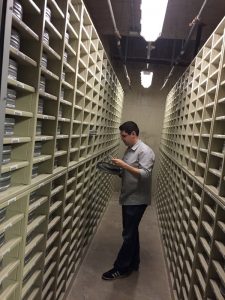
Brian Cruz interning at the LOC, inspecting films from perhaps the most frustrating collection, for various reasons.
Considering the current state of technology as part of the picture of restoration and preservation presents similar problems to what has always existed: What to preserve, why these ones first, and what is the best way to do it? This of course is true with film or any other material.
In thinking about films still owned by a larger company:
The foresight of a company to preserve their history beyond just being motivated by the possibility of future profit from this material either relies on a companies overarching mission to include such a provision, or, if not there, an almost personal dedication to help the wheels of the major missions of the company to somehow allow this to happen in one way or another.
Countless bungles have been made by large companies relating to their own legacies, both in their various sorted histories and, sadly, even today. As observers of this its frustrating in that decisions are made that seem unimaginably short sighted. Its important to understand that, as an observer, you are only seeing a small piece of the large structure that allows those seemingly short-sighted decisions to stand.
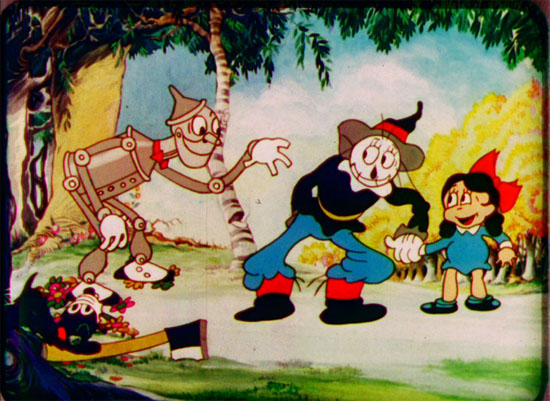
Ted Eshbaughs The Wizard of Oz. saved in 35mm Technicolor for all of us with great foresight by the Library of Congress
As a company, Disney’s care for their original nitrate elements is excellent – far beyond most. As you are reading this, chances are reels from well known (or not as well known) film they produced are being carefully checked for any issues. There’s a lot more film that is stored at the same facility and owned by large companies – with sparse chance of having their cans opened in any rotation – there are just too many of them to accomplish this without the resources put toward it.
Several years back I was amazed to find out that one large studio has stopped worrying at all about any of the scanning of their nitrate material; they has switched almost entirely to scanning all materials stored in New York in the 50s through the early 60s (and some in California). These materials, even though they were on safety film stock and had been stored well for the last 20 years or so, had not been stored well earlier in their lives, and this earlier lack of proper care was causing the material to de-gass much faster (acetate decomposition, sometimes known as vinegar syndrome as weve talked about). This studio decided (I think correctly) to scan *all* materials stored in that archive under the assumption they were all in peril. Having the archives be able to make an expensive call that that is what drives the ability to not lose the material.
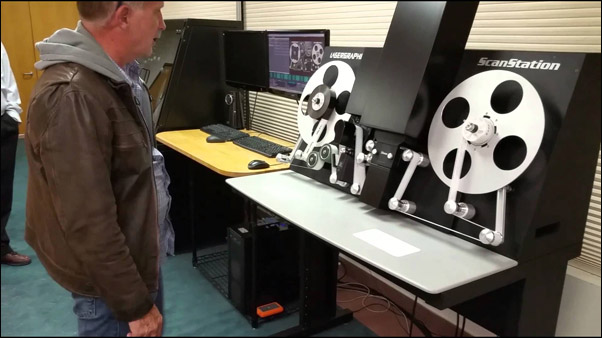
Lasergraphics Scan Station, a top of the line 5k Scanner for motion picture film
This current top scanning technology is quite remarkable, and easily beats the older way of making a duplicate master by contact printing. This version of preservation was effective of course and saved many films. Of course, the current technology (scanning) would allow a much finer reproduction back to that same 16 or 35mm material, removing the loss of a photographic generation as well as the mechanical play. Digital technology is amazing in this regard, especially with older, shrunken materials- but I think there still is a need to preserve back to film, even if this is considered a backup. In some ways, this functions as a protection master, just as making a master positive did.
I may privately rail against certain things at certain times, but just the fact that things are getting preserved in any way makes me happy. The mistakes being made now are, honestly, similar to the mistakes of the past, but if were lucky what were doing now will hold out long enough to make sure the quality is preserved in a technology that will be as good as film; in many cases, that decision has already been made.
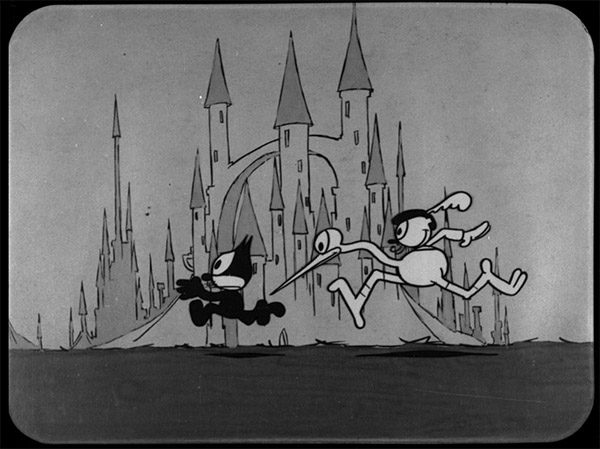
Original camera negs (or even 35mm prints) of Felix the Cat shorts are very rare
There are plenty of people that will both agree and disagree with my own thoughts of the best ways to preserve right now, but the key is to preserve, period. Why? For future ability to enjoy, understand and inspire. Our ability now to support these efforts with positive energy is important, because positive movement by large companies often allows a smaller company and archive the ability to afford the technology to at least perform some of the steps in the direction of preserving films.
We did 4K (and some 5k) on all the Iwerks’ Willie Whoppers. We certainly didnt need to in producing a Blu-ray/ DVD set, but because the demand for the technology drove the ability to use this technology much more affordably, we have excellent scans of the best materials that exist on this series. The same is true for the Flip the Frog’s. Some of the nitrate on these films is now nearly 90 years old; the new scans are done now and can go back to film regardless of the original element conditions should interest be there to do them. It’s just one studio of course, but Its a start at least.
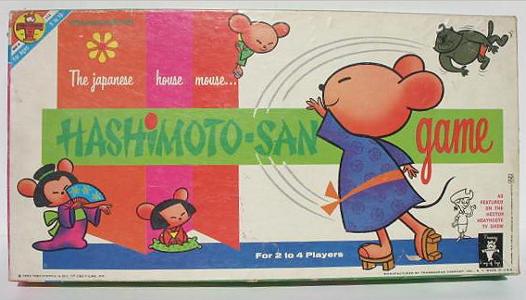
Are all of Hashimoto San’s adventures protected from vinegar syndrome?
Have a good week everyone!


 Steve Stanchfield is an animator, educator and film archivist. He runs Thunderbean Animation, an animation studio in Ann Arbor, Michigan and has compiled over a dozen archival animation DVD collections devoted to such subjects at Private Snafu, The Little King and the infamous Cubby Bear. Steve is also a professor at the College for Creative Studies in Detroit.
Steve Stanchfield is an animator, educator and film archivist. He runs Thunderbean Animation, an animation studio in Ann Arbor, Michigan and has compiled over a dozen archival animation DVD collections devoted to such subjects at Private Snafu, The Little King and the infamous Cubby Bear. Steve is also a professor at the College for Creative Studies in Detroit.






















I wish all of the studio people could read this. It sums up, very nicely, the need to preserve.
Steve, if you’re in Toronto, give me a shout. I’m busy all day Saturday, but available other days. You should have my email address. If not, respond to this and I’ll email you.
That Hashimoto San vinegar syndrome was funny because it’s random. I saw the Oscar consideration blog posts by Jerry and coincidentally that character’s pilot was one of the cartoons considered for nomination.
you must be begging Viacom to release more of their cartoons, especially the Terrytoons.
I would love to see the Hashimoto San Cartoons restored preserved on DVD and Blu Ray . My personal favorites from the Hashimoto San Series are
House of Hashimoto where Hashimoto San was telling a Japanese folk tale about a young invisible mouse who help defended his village against a Oni Cat Demon,
Honorable Family Problems where Hashimoto tries to protect his family and his traditional Japanese culture from a invading influences from the West including Go Go dancing and Rock and Roll
And Doll Festival where a Japanese House Cat named “Ken Taki” (a play on the word Kentucky) try to infiltrate the Doll Festival which Hashimoto and his family were attending by disguising himself as a Gheisha doll.
All these Hashimoto San cartoons were created by Rokuro “Bob” Kuwahara as a “Labor of Love” showing the Japanese culture in a positive characterization and manner instead of a negative stereotypical view that was the norm back then (with the exception of Van Buren’s Japanese Lanterns/Chinese Lanterns (1935)).
This is a terrific article Steve! This is why I’ve been devoting a lot of my film history work to recognize Jam Handy, Frank Goldman, Jerry Fairbanks, those ‘GM ABC Power Trio’ films etc.
I never tire of reading about film restoration, especially from people like you that see the importance of it. We have so many great Blu-Ray/DVD collections thanks to your foresight. Keep up the good work!
Steve,
There’s no real reason to preserve digital copies of nitrate back to film. You should be making three backup copies of all digital files you create to magnetic tape at least monthly. One copy gets stored onsite, another copy gets stored regionaly offsite and the last copy goes to a long term storage facility such as Iron Mountain where tapes will be safe for at least 50+ years.
Will there be players capable of playing those tapes 50 years from now? Or is it definite that during those 50 years the files will be consistently migrated to newer media formats as they come along? On the other hand, a film that was just sitting around in a safe and secure environment for 50 years will reveal the visual information stored thereon by methods as simple as holding it up to the light and looking at it.
Paul,
There most certainly will be. This is the industry standard and thousands of businesses rely on this technology. I can still read tapes written in the 1970s today.
Best practice is the archive everything at least yearly, so you should never have to go back further than last year’s tapes unless something really weird happened.
I can only imagine the strenuous series of steps it takes to fully restore the images and sound quality of films dating back even just 50 years, let alone to decades that I cherish at this moment, and I just hope that you can keep up with that arduous task as film decay is sometimes faster than the dilligent efforts to fully restore. This not only goes for cartoons and classic film, but to vaults and vaults of music of all genres. It may seem an easier task to restore audio, but I am often amazed and dismayed to hear that even the master tapes to some of my all-time favorites has deteriorated to where the industry dare not take on the expensive and expansive task of reissuing the product, because truly replicating the analogue sound as we remember it is almost impossible with changing technologies.
And each new day, I wish I actually knew more about this process, because it is amazing that, frame by frame, we actually now *CAN* restore film to nearer to its original state than we ever thought possible even ten years ago, when so many of us were indeed seeing some of those desirable holy grails that we’ve often asked for. Here’s hoping you can still tough it out and bring us those cherished cartoons, so familiar and so new to us all over again. I’m always hearing about so much promised material, and I’m glad that there are folks out there like yourself and Jerry Beck and even private collectors who collect to preserve!
The title says it all: “Why Restore? Why Even Save Any of This?”
You got that right. Cartoons is baby stuff. Let’s toss ’em all in the dumpster and move on. Why preserve a bunch of dopey cats, mice, sailors and floozies drawn by bums and marketed by greedy capitalists to the undiscriminating yokels that paid good money to try to escape their bleak and dreary lives? Good luck! The whole enterprise stinks to high heaven. Thanks for having the courage to state the obvious.
I’m outta here! Pour me a double!
Thank you Peter for the honest criticism displayed here!
I get a headache just thinking of all the effort. Here we see the BFI back in 2009 try to restore a live-action British short of importance (especially since the live-action shorts get even less attention than the animated ones): https://www.youtube.com/watch?v=FiCB6BWbd2k
“Digital technology is amazing in this regard, especially with older, shrunken materials- but I think there still is a need to preserve back to film, even if this is considered a backup.”
Absolutely. Doing film outs is common sense, as film is the only true archival format for preserving images and sound long-term. Digital, on the other hand, is not at all “archival.” Neither is magnetic tape as someone mentioned above.
That was really interesting. I didn’t realize some film was being scanned as high as 5k. No wonder the Willie Whopper shorts looked so good. I’m also glad to hear the need to archive film as film is recognized. I’m glad this is being done for some films. I just wish more had been done earlier for more films by the big studios.